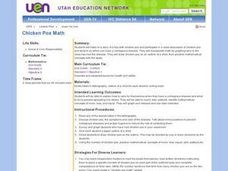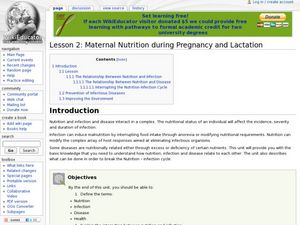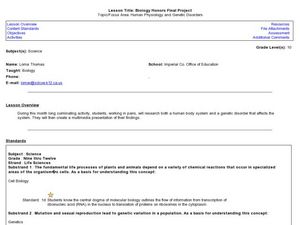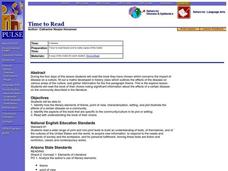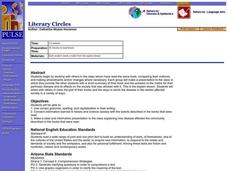Curated OER
Ways to Prevent the Spread of Pathogens
Fifth graders discuss the ways to prevent the spread of pathogens. In groups, they use the internet to research the ways to prevent disease from spreading. They use this information to create a poster and share the information with the...
Curated OER
Chicken Pox Math
Second graders are read a story about a boy with chicken pox. As a class, they discuss what to do when you have a contagious disease and identify who in the class has had chicken pox. Using this information, they create a graph and use...
Curated OER
Waterborne Diseases
Students compare symptoms of several well-known water-borne diseases. They use the symptoms and background information on the disease to explain some of the aspects in terms of immune response.
Curated OER
Infectious Disease Case Study Part I
Eleventh graders work together to complete a simulation on infectious diseases. They determine which concepts affect a disease more. They complete discussion questions as well.
Curated OER
Parasites and You
Twelfth graders investigate parasites and how parasite-borne diseases are spread. They conduct Internet research, answer handout questions, and identify methods that could reduce parasitic diseases in various countries.
Curated OER
Disease Lesson
Ninth graders examine rates, matrices, histograms, line graphs, data analysis and data presentation in order to develop an understanding of how these concepts apply to a the effects of a specific disease.
Curated OER
Communicable Disease
Students use Palms, or handheld computers, and the Cooties software to enact the transmission of communicable diseases. They discuss incubation and immunity and collect and interpret data and figure out who was the "carrier "of a "disease."
Curated OER
Using Sterile Techniques as a Tool in Studying Plant Diseases
Seventh graders examine the concept of sterile techniques. They realize that plant diseases can be identified and classified in various way. Students identify some of the diseases that attack the garden plants.
Curated OER
Maternal Nutrition during Pregnancy and Lactation
Students explain the relationship among nutrition, infection and diseases. For this health science lesson, students suggest ways to break the nutrition-infection cycle. They brainstorm solutions to prevent infectious diseases in the...
Curated OER
Health and Hygiene
Students examine hygiene and health practices today. For this health science lesson, students research medieval treatments to ailments common today. They evaluate how effective herbal remedies are in treating diseases.
Curated OER
Biology Honors Final Project
Tenth graders work on a project about cellular biology and genetics. In this biology lesson plan, 10th graders research about the assigned human body system and genetic disorders that affect it. They create a multimedia presentation and...
Curated OER
Protecting the Herd
Students simulate the spread of a fictitious disease using an internet-based simulation. For this biology lesson, students predict the factors that could affect epidemic. They investigate these prediction using computer simulation.
Curated OER
Genital Herpes
In this health worksheet, students find the words that are associated with the disease of genital herpes. The answers are found at the bottom of the page.
Curated OER
Glaucoma Word Search
In this health worksheet, students find the words that are related to glaucoma and the answers are found by clicking the link at the bottom of the page.
Curated OER
The Hantavirus Haunting: Solving the Case
Students engage in research about the hantavirus. They use a variety of resources to obtain information. Students distinguish the differences between hantavirus pulmonary syndrome, hantavirus transmission, and hantavirus prevention.
Curated OER
Bovine Spongiform Encephalopathy
Seventh graders investigate the problem of BSE. They conduct research and are able to explain the history in written or oral form. Students describe the causes of BSE and its dangers that are posed to the public. They discuss the kind of...
Curated OER
Diseases Are Real
Eleventh graders research industries that contribute to sanitation and pollution problems. They investigate the direct result of unhygienic practices including disease outbreaks or specific illnesses. They create a Power Point...
Curated OER
Science Happens in a Social Context
Students discuss how the same data is viewed differently between historians and scientists. Using the data, they compare and contrast the vocabulary used and the focus of attention. They analyze the conditions that help spread diseases...
Curated OER
Time to Read
Young scholars identify how the literary elements of theme, point of view, characterization, setting, and plot illustrate the effects of a certain disease on a community. They identify the aspects of the book that are specific to the...
Curated OER
Literary Circles
Students use correct grammar, spelling and capitalization in their writing. They connect information acquired in history and science classes with the events described in the books that were read. Students make a clear and informative...
Curated OER
The Impact of Disease on our Lives
Students explore infectious diseases. They analyze the effect of a disease on the community. Students develop a public health policy that addresses the containment of the epidemic. Students create a policy and present findings as part...
Curated OER
Life at Sea: Sores, Scabs, and Scurvy
Students study the diseases that sailors contracted. They examine the ways that Captain Cook used to prevent illness in his crew.
Curated OER
"Attack A Cell, Any Cell" Disease Unit
Seventh graders use the Internet to gather information about a disease. They also discuss in groups how diseases are a worldwide problem and brainstorm ideas they can help. They create an informational packet on the disease they researched.
Curated OER
"Asthma: Stopping Attacks Before They Start"
Students study facts about living with asthma. They examine medical treatments and lifestyle changes that can improve the life of asthmatics. They determine the cause and effect relationship.



